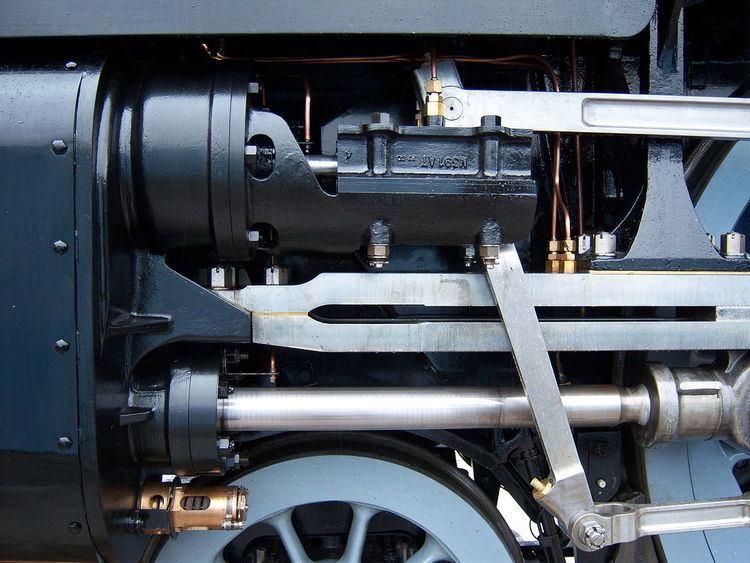 | ||
The cylinders of a steam locomotive are the components that convert the power stored in the steam into motion.
Contents
- Early locomotives
- Direct drive
- Inside or outside cylinders
- Three or four cylinders
- Crank angles
- Valves
- Inside cylinders
- Outside cylinders
- Valve gear
- Three cylinders
- Four cylinders
- Other variations
- References
Cylinders may be arranged in several different ways.
Early locomotives
On early locomotives, such as Puffing Billy, the cylinders were often set vertical and the motion was transmitted through beams, as in a beam engine.
Direct drive
The next stage, for example Stephenson's Rocket, was to drive the wheels directly from steeply inclined cylinders placed at the back of the locomotive. Direct drive became the standard arrangement, but the cylinders were moved to the front and placed either horizontal or nearly horizontal.
Inside or outside cylinders
The front-mounted cylinders could be placed either inside (between the frames) or outside. Examples:
In the 19th and early 20th centuries, inside cylinders were widely used in the UK, but outside cylinders were more common in Continental Europe and the United States. The reason for this difference is unclear. From about 1920, outside cylinders became more common in the UK but many inside-cylinder engines continued to be built.
Inside cylinders give a more stable ride with less yaw or "nosing" but access for maintenance is more difficult. Some designers used inside cylinders for aesthetic reasons.
Three or four cylinders
The demand for more power led to the development of engines with three cylinders (two outside and one inside) or four cylinders (two outside and two inside). Examples:
Crank angles
On a two-cylinder engine the cranks, whether inside or outside, are set at 90 degrees. As the cylinders are double-acting (i.e. fed with steam alternately at each end) this gives four impulses per revolution and ensures that there are no dead centres.
On a three-cylinder engine, two arrangements are possible:
Two arrangements are also possible on a four-cylinder engine:
Valves
The valve chests or steam chests which contain the slide valves or piston valves may be located in various positions.
Inside cylinders
If the cylinders are small, the valve chests may be located between the cylinders. For larger cylinders the valve chests are usually on top of the cylinders but, in early locomotives, they were sometimes underneath the cylinders.
Outside cylinders
The valve chests are usually on top of the cylinders but, in older locomotives, the valve chests were sometimes located alongside the cylinders and inserted through slots in the frames. This meant that, while the cylinders were outside, the valves were inside and could be driven by inside valve gear.
Valve gear
There are many variations in the location of the valve gear. In British practice, inside valve gear is usually of the Stephenson type while outside valve gear is usually of the Walschaerts type. However, this is not a rigid rule and most types of valve gear are capable of being used either inside or outside. Joy valve gear was once popular, e.g. on the LNWR G Class.
Inside cylinders
On inside-cylinder engines the valve gear is nearly always inside (between the frames), e.g. LMS Fowler Class 3F.
Outside cylinders
On engines with outside cylinders there are three possible variations:
Three cylinders
There are three common variations:
Four cylinders
There are three common variations:
Other variations
There are many other variations, e.g. geared steam locomotives which may have only one cylinder. The only conventional steam locomotive with one cylinder that is known is the Nielson One-Cylinder Locomotive.
